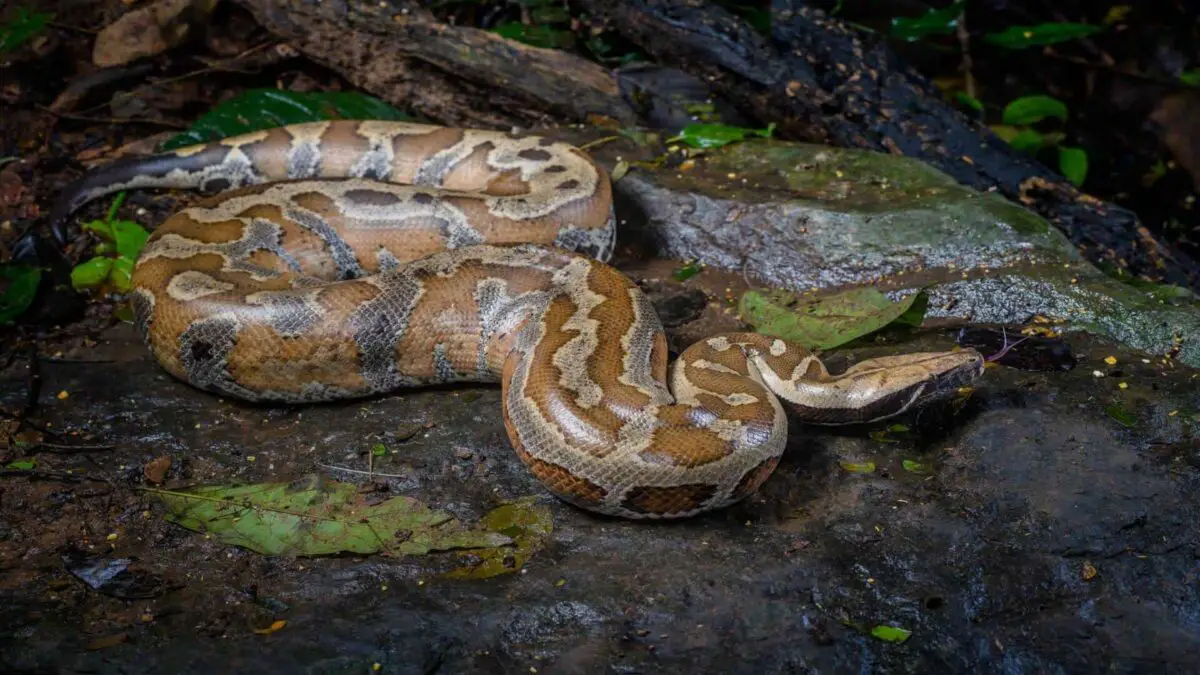Comprehensive Blood Python Care Guide
Bloods have an imposing and almost unbelievable size and girth. Their incredibly rich and vibrant colors along with one of the most striking heads of any snake are just some of the things that make blood pythons so popular!
Blood pythons are best kept in 4 ft by 2 ft enclosures with 60-70% humidity levels. A thermal gradient should be set up in the enclosure with the cool side temperature between 80-84°F and the warm side between 86-88°F. (27-29°C and 30-31°C)
Reptile Roommate is a participant in the Amazon Services LLC Associates Program. As an Amazon Associate I earn from qualifying purchases.
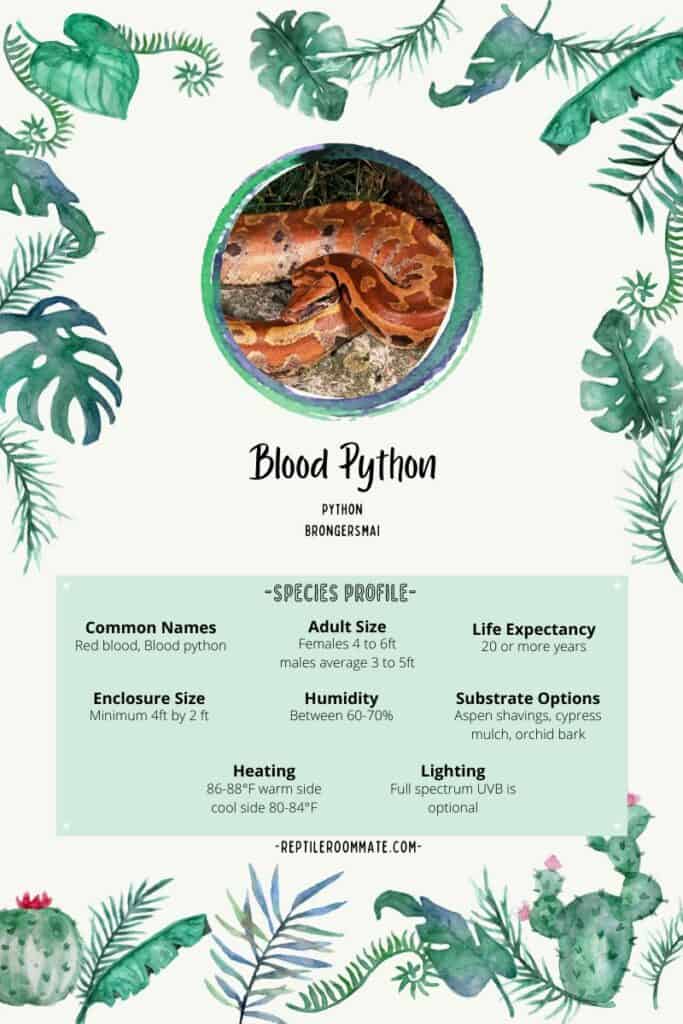
Blood Python Habitat
Blood pythons are native to western Malaysia and some surrounding islands.
Bloods are ground dwelling ambush predators spending most of their time hidden among leaf litter on the forest floor.
They can spend long periods of time hidden away waiting for an opportunity to feed on prey that happens to cross their path.
Blood Python Size and Weight
Maximum adult length of these snakes averages about 6 ft. Females, on average, grow anywhere from 4 to 6 ft and tend to be a bit bigger than males that average between 3 and 5 ft.
Blood python’s head are heavily muscled and wedge-shaped and oftentimes these snakes can look obese given their very heavy and robust bodies.
Blood Python Lifespan
Blood pythons can live more than 20 years in captivity!
Like most pet reptiles, and snakes in particular, keeping them is a commitment that is oftentimes measured in decades and not years.
Be prepared to care for your blood python for many, many years.
Blood Python Colors and Morphs
In the wild blood pythons are richly colored bright red, orange, and reddish-brown.
Their bodies have yellow to tan blotches and stripes that run the length of their body with black and brown spots along their sides.
Captive bred blood pythons come in absolutely gorgeous colors and patterns! Albinos, shades of yellow, blondes, extreme red and many more.
We guarantee that you’ll be able to find a blood python that will amaze you with it’s coloration and pattern!
Are Blood Pythons Good Pets?
Often blood pythons get a bad rap. It may have a little bit due to their name “blood” pythons and in large part due to people misunderstanding them.
However, their care and set up is simple and undemanding as long as the keeper meets their basic care and requirements needs.
Blood pythons can also be very manageable and handleable pets.
Blood Python Temperament, Are They Mean?
Blood pythons are primarily crepuscular; active around dawn and dusk.
Bloods spend much of their days resting or hiding in one of their caves or burrows that you’ll provide in their habitat, if not just simply hidden under the substrate.
Blood pythons are ambush predators, they lie in wait for a potential prey item to cross their path.
..and when prey does cross their path…
…blood pythons are lightning quick! …and strike in the blink of an eye!
Are Blood Pythons Aggressive?
Some people refer to blood pythons as “springs with teeth” because of their lightning quick reaction time and because they are often wrongly labeled as ‘mean.’
Blood pythons are terrestrial ambush predators. This means that they spend nearly all their time on the ground and hiding under the substrate or cover.
Just the fact that we pick up our blood pythons off the ground and hold them ‘in the air’ can make them nervous.
Much of blood python’s bad reputation comes from the early days when wild caught animals were first imported into the country.
These snakes did tend to be more “aggressive.”
However, with many years of selective, captive breeding this “aggression” has been bred out.
Secondly, uncovering or exposing the animal (which is used t being hidden) can also cause the blood to be nervous.
Blood pythons, like all snakes, aren’t mean. There are only two reasons that any snake will bite you.
One, they mistake you for food. Two, they are highly stressed and frightened and think that biting is the last resort.
Blood pythons can make excellent pets, pets that you can handle and enjoy without the fear of being bitten or being afraid of a ‘mean snake.’
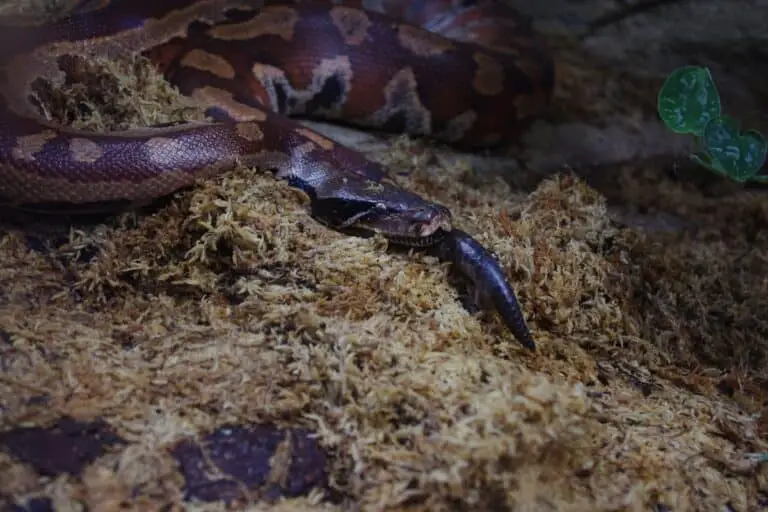
“Blodpython – Blood python – Python brongersmai” by Staffan Vilcans is licensed under CC BY-SA 2.0
How to Handle a Blood Python
Like with many snakes you have to build trust with your blood python.
You want your snake to know that no harm will come to it while you are handling it.
You need to establish a routine, such as gentle taps on the head with a roll of paper towels or even a small snake hook to communicate that “that is not feeding time but handling time.
If you can prevent your blood python from confusing you with food, you’ve won half the battle!
The second half of the battle is earning trust and not putting your snake in a position where it is overly nervous or scared for its safety.
Like with any reptile, initial contact should be slow and steady and trust is developed over a period of time gently handling the snake for a few minutes every day or so for a week to a couple of weeks.
Blood pythons being terrestrial snakes always need you to support their bodies in order to feel safe and secure.
Once your blood python realizes that you pose it no threat, they can be handled with ease and are a pleasure to hold.
Lastly, avoid handling your blood python when it is in shed and soon after it has consumed a meal. Snakes in shed have impaired vision and are much more nervous given their vulnerable state.
Waiting a few days after you blood has eaten will help to ensure that it doesn’t stress out the snake and lead to it regurgitating its meal.
Blood Python Enclosures
On average, an adult blood python will require an enclosure from 36”L x 12”W (average adult) to 48″L x 24″W (the largest of blood pythons).
Hatchling and juvenile blood pythons are often housed in smaller, more secure-feeling, enclosures while they grow into adults.
They are systematically moved to large and large enclosures until they reach full size.
Many blood python keepers, and especially breeders, keep their bloods in rack systems. Most blood python rack systems use tubs of @ 3-4ft in length+ 18 to 24 inches in width.
Some of advantages of rack systems are that they allow breeders to house large numbers of snakes and they afford easy cleaning and maintenance of the enclosures.
Even as some may frown on snakes being kept in a rack system, cleanliness and the snakes welfare ALWAYS need to come first.
So, if having a rack system means that you’ll be able to provide a cleaner, healthier, and more stable environment then they are a great way to house your snake.
You will need to spot clean the enclosure as needed and do a full tear down of the tank/habitat monthly to clean and disinfect it.
Blood pythons should be housed individually and not in pairs or groups.
Blood Python Humidity
Blood pythons require humidity levels between 60-70% which is a bit higher for other popular pet snakes.
In order to maintain the humidity you may need to occasionally mist the enclosure or, if your habitat has one, cover part of the mesh screen top to retain moisture.
Misting can be down with a simple spray bottle. Humidity will also be boosted depending on how easily the substrate holds moisture and by maintaining a water bowl in the enclosure.
Using a hydrometer, a device for measuring humidity makes easy work of maintaining proper humidity levels. Fortunately they are inexpensive and readily available.
Substrate for Blood Pythons
Your blood python’s substrate can be as simple or as complicated as you want. The main purpose of the substrate is to provide a surface for the snake to live in/on, to be efficiently and effectively cleaned, and to be visually appealing.
Substrates such as aspen shavings, cypress mulch and orchid bark (both help maintain humidity), or even something as simple as newspaper or paper towels can work great!
Never use substrates containing cedar as it is deadly to reptiles.
Hides
Hides help provide your blood python a secure place to feel safe.
Hides can be as simple as a few extra sheets of paper used for substrate, an extra deep layer of aspen or cypress mulch, to cork bark flats and decorative hide boxes.
It is important that hides be easily accessible, provide a safe and secure place for your snake, and be easily replaced and/or sanitized.
For those keepers that use newsprint or kraft paper, a few extra sheets, folded and placed on top of paper substrate, works as an excellent and easily replaced hide.
Coco fiber or mulch can be added to the enclosure in deep layers giving your blood python the ability to burrow into and lay under, providing an excellent hide spot.
Lastly, more decorative items such as moulded hide boxes, overturned bowls, cork bark and the like can be used as hides for your python.
…just keep in mind that some of these (cork bark, etc) may be more difficult to clean and sanitize than other options.
Whichever type of hides you choose to use just be sure that they are easy to maintain and will provide your blood with the safety and security that it requires.
Blood Python Temperature and Heating
Blood pythons need temperature gradients(zones). Their enclosure should have a “warm side” and a “cool side.”
The warm side should range in temperature from 86-88°F and the cool side from 80-84°F.
The most effective means of heating your blood python’s enclosure is by an under-tank heating pad or mat. You can also heat the enclosure with a heating lamp or ceramic heat emitter directed from the outside of the enclosure. (set on top of the screen lid)
NEVER use heating rocks or stones that go inside of the habitat. These can cause severe burns and even death!
An accurate thermometer is a must for any blood python enclosure.
Do Blood Pythons Need UVB Lighting?
Blood pythons have no need for special UVB or supplemental lighting.
However, a photoperiod of 10-12 hrs a day by using a simple fluorescent light (on a timer or turned on/off manually) is standard practice.
Blood Python Feeding and Water
Clean, fresh water should be available at all times
A large, stable water dish should be provided. The water dish should be large enough that your blood python can soak in it. Soaking can be very important during shedding.
The water dish should be cleaned and disinfected weekly and as needed as blood pythons are known to drink frequently.
Blood Pythons are Great Eaters
Blood pythons are known for having great appetites, strong prey response, and few issues with refusing meals. (basically the opposite of ball pythons!)
Blood pythons are able to utilize the nutrition they receive from food very efficiently.
This means that they don’t require large meals like comparably sized snakes or frequent feedings to grow into adulthood or maintain good size and weight.
Rats are a blood python staple. Bloods can be fed rats throughout their lives.
Hatchlings can be started on fuzzy rats and quickly move onto larger rats as juveniles and adults.
Like with most snakes, blood pythons should show a slight bulge in its midsection from the meal, when fed an appropriately sized rat.
There is no need for your snake to have a big lump in its stomach or look like it swallowed a beach ball!
For most blood pythons a weekly feeding schedule is optimal as hatchlings all the way until adulthood; at which time feedings are scheduled every two weeks.
Blood python’s slow metabolism and ability to extract maximum nutrition from their meals, can cause them to gain weight quickly and even become obese.
As adults feeding frequency will need to be monitored and adjusted based on your snakes body composition.
Feeder Rodents
Benefits of feeding frozen/thawed:
Should I feed live rodents or feed previously killed frozen (and then thawed) rodents?
The best option, for both you and your blood python, is to purchase frozen rodents that you can thaw and feed to your snake.
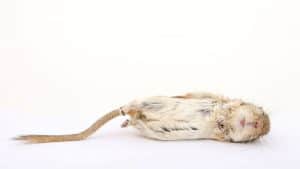
Benefits of feeding frozen/thawed:
- It is convenient
- It’s parasite free
- Rodents cannot harm or cause injury
- More economical because you can buy in bulk
- Frozen rodents are easier to store than live rodents
A second (and admittedly sometimes necessary) option is to feed your blood python live rodents.
Live rodents are what blood pythons eat in the wild. They have evolved to be extremely good predators and are built for hunting, subduing, constricting, and eating rodents.
However, in a captive environment feeding live animal prey is not ideal for a number of reasons.
3 reasons not to feed live rodents
- If left unattended a live rodent can harm, injure or (yes) even kill your snake
- There is the possibility of introducing disease or pests to your snake/enclosure
- Live rodents can be difficult/time consuming/messy/smelly to house
Rodent bites, especially bites from a rat, can do great harm to your snake. IF you do feed live rodents make sure not to leave your snake (and the rodent) unattended until the snake has captured and constricted its prey.
Feeding Issues
Blood pythons rarely have issues feeding.
However, it is common for snakes to refuse food when they are going into shed and there’s nothing wrong if your blood refuses a meal at this time.
If your blood python isn’t in shed and is refusing to eat, it’s likely that they are entering breeding season or there are problems with your husbandry.
Heat, (or lack of it) environmental stress, humidity issues, and constant handling or changes in their enclosure can make your snake refuse food.
Snakes are cold-blooded animals and as such rely on environmental temperature ranges to regulate bodily functions, including digestion.
Try to provide consistent temperature gradients every day so that your blood python can better regulate itself.
Providing adequate hides for your snake is one of the best ways to reduce stress on your animal. A blood python that is too stressed may refuse to eat or prove to be a finicky eater.
Sometimes illness or health issues will cause a snake to stop eating. If your snake refuses food make sure to examine it for any signs of illness such as fluid coming from eyes or nostrils, wheezing, or mites and ticks present in and under your snakes scales.
As long as your python isn’t ill and you have made sure that husbandry requirements are met, you should have very few problems with feeding your blood python.
The Bathroom; Blood Python Edition
So, remember all that talk about blood pythons having slow metabolisms and being super good at extracting the most nutrition out of their meals?
Well, that leads to some “uniqueness” in the bathroom department!
It is not uncommon for adult blood pythons to go months (and sometimes months and months and months) and not defecate.
…and all that time they’ll be eating regularly!!
This can be a real surprise to those unaware. Not having your blood python defecate for 4, 6, or even more months can be quite unsettling to new keepers.
However, this is normal. It’s actually a positive of owning blood pythons as cleaning up waste isn’t the most fun and the less you have to do it, the better!
That said, when they do go….
Well, let’s just say, they GO!
Do Blood Pythons Shed?
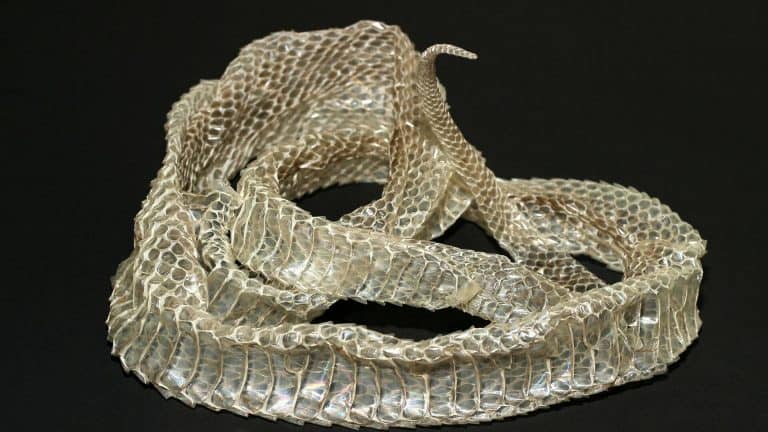
All snakes shed their skin and blood pythons are no exception. Blood pythons continue to grow throughout their lives and as their body increases in size they need to shed their skin to accommodate for this growth.
Shedding can also be beneficial because it may help remove parasites like mites or ticks.
Snakes go through a shedding cycle which can last between 1 and 2 weeks.
The Pre-shed
During this pre-shedding phase you’ll notice that your python’s colors appear dull and a bit darker than usual. You may also notice the snake’s eye becoming darker as well or appearing faded.
Some blood pythons will display a pink blushing or tint to their belly. Your snake may begin to refuse to eat at this point which is completely normal!
(once they do refuse food, it’s probably best to stop offering it until they have completed their shed)
Blue
The second part of the pre-shed is what’s known as “being in blue” or the “blue phase.”
Being in blue means that your blood python’s eyes will get cloudy, and appear to be a milky-blue color. Your snake’s skin will also appear to be a lot less colorful and much duller than it usually does.
Your blood is easily stress during this stage. Cloudy eyes make it hard to see and the impending shed can make your snake particularly uneasy.
Your python will spend much of its time hiding and become defensive if you attempt to handle it or are active in its enclosure. It’s best to just give your snake the space it needs.
It can be a good idea to keep a diligent eye on the enclosure’s humidity levels; even increasing them a bit up tp 70-80%.
You can introduce a “humidity box,” or hide filled with slightly damp sphagnum moss to assist your snake in the shedding process.
Approximately 3-5 days later your blood python may begin to look “normal” again. Many new snake keepers wonder, “What happened? Is my snake not going to shed now?”
Clearing
This “clearing stage” is a normal part of the shedding process as all the fluid between the old and new layers of skin clears up and makes the snake appear much more colorful and brighter.
When your snake “clears up” after “being in blue,” you know the shed is about to begin!
In 2 to 3 days after your blood python has shown signs of the pre-shed “clearing” your snake will soon shed its skin. Snakes tend to shed at night when they feel less stressed and more secure, so you may not see your python shed at all.
The Shed
Your snake may rub its nose against a hide, a decoration, the enclosure wall or substrate to get its skin to begin to peel or crack.
Once its skin begins to peel the snake will wriggle and squirm and move its way around the enclosure rubbing up against anything it can find to help remove the old skin.
Most often a fully shed snake’s skin will come off in one piece, eye caps and the tip of the tail included!
Your blood python may eat a short time after completing its shed or it may skip another meal.
Either is perfectly normal. If your snake does refuse to eat, just try to see if it will feed at the next scheduled meal.
Common Health Problems
Vomiting and regurgitation
The most common cause is from poor husbandry (care). Handling your blood python too soon after feeding can cause your it to vomit/regurgitate. Low enclosure temperature can also cause your snake to vomit/regurgitate.
These two causes account for almost all instances of vomiting and regurgitation. They are both easily corrected.
Diseases resulting in mouth rot
Mouth rot, a symptom of various diseases, is a consequence of unclean habitat conditions, poor husbandry skills, and malnutrition.
Poor shed with retained eye cap
Low humidity, handling your snake while in shed (damaging underlying skin), and low temperatures can lead the eye caps (protective skin covering the eye) to not be shed.
Poor husbandry and an unclean environment will lead to disaster EVERY TIME!
If you are unable to provide a blood python (or any reptile) with the proper environment, please reconsider this choice of pet for the time being.
If you have any questions or concerns about your blood python’s health please contact your local veterinarian!
Blood Python Care Conclusion
This blood python care guide was developed with both you and your snake in mind!
We hope that the information contained here can get you off to a great start and help keep your snake happy, healthy, and in the best shape possible!
As always, good luck and thank you for stopping by!
“Python brongersmai, Brongersma’s short-tailed python – Kaeng Krachan National Park” by Rushen is licensed under CC BY-SA 2.0

